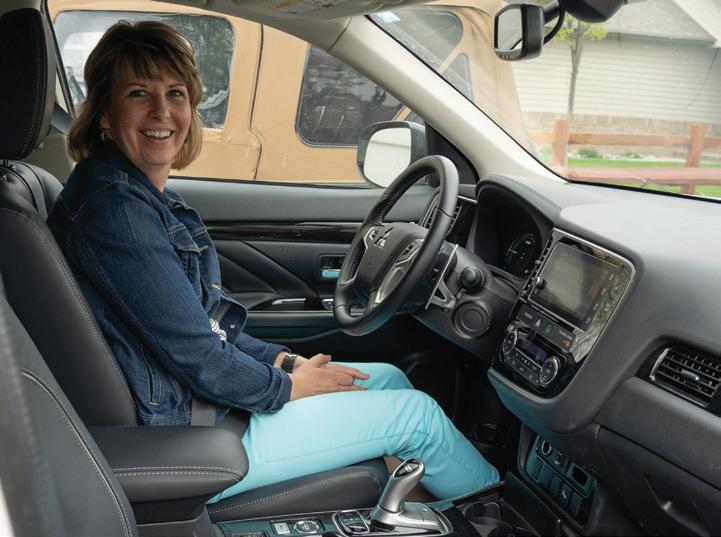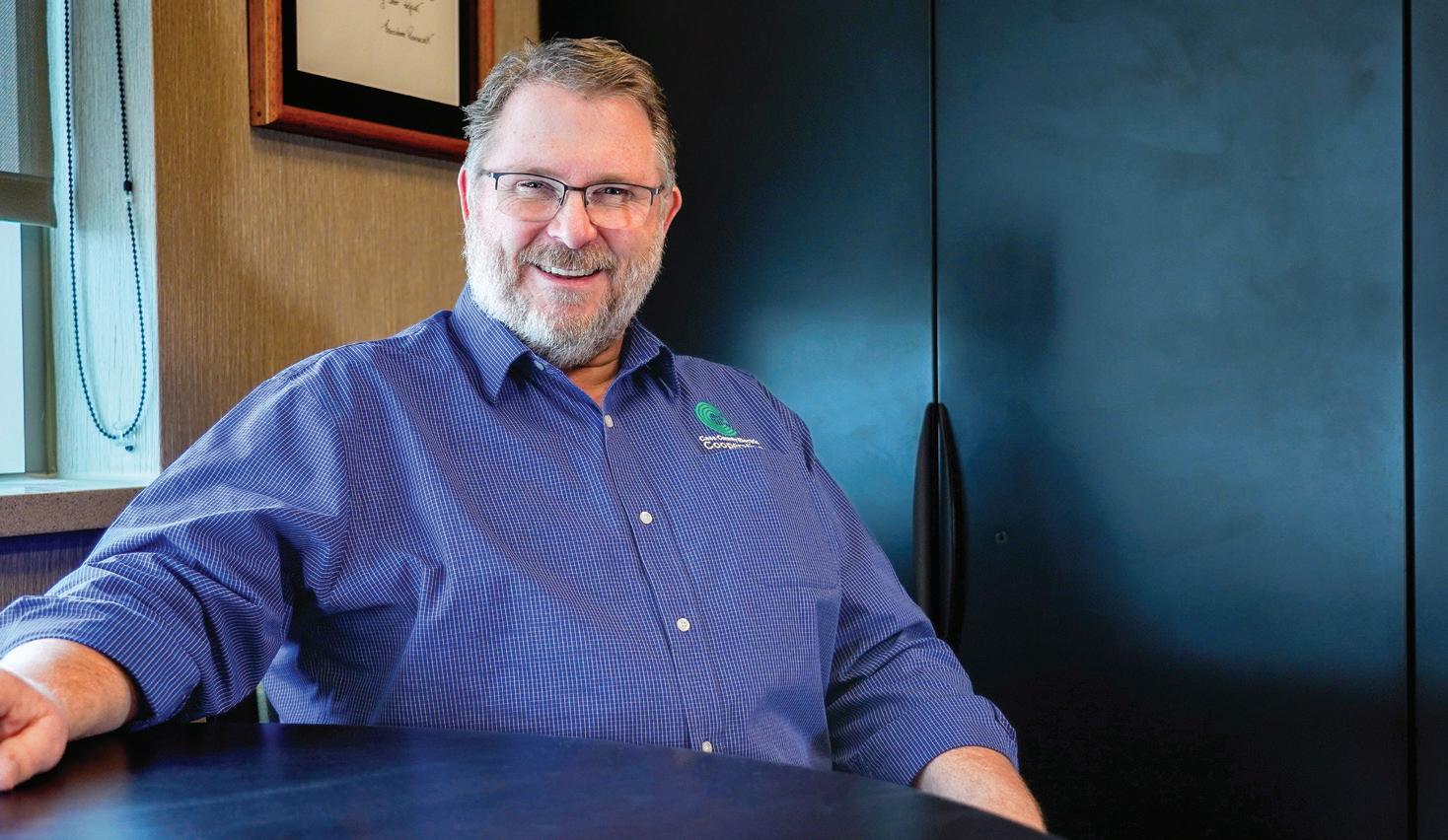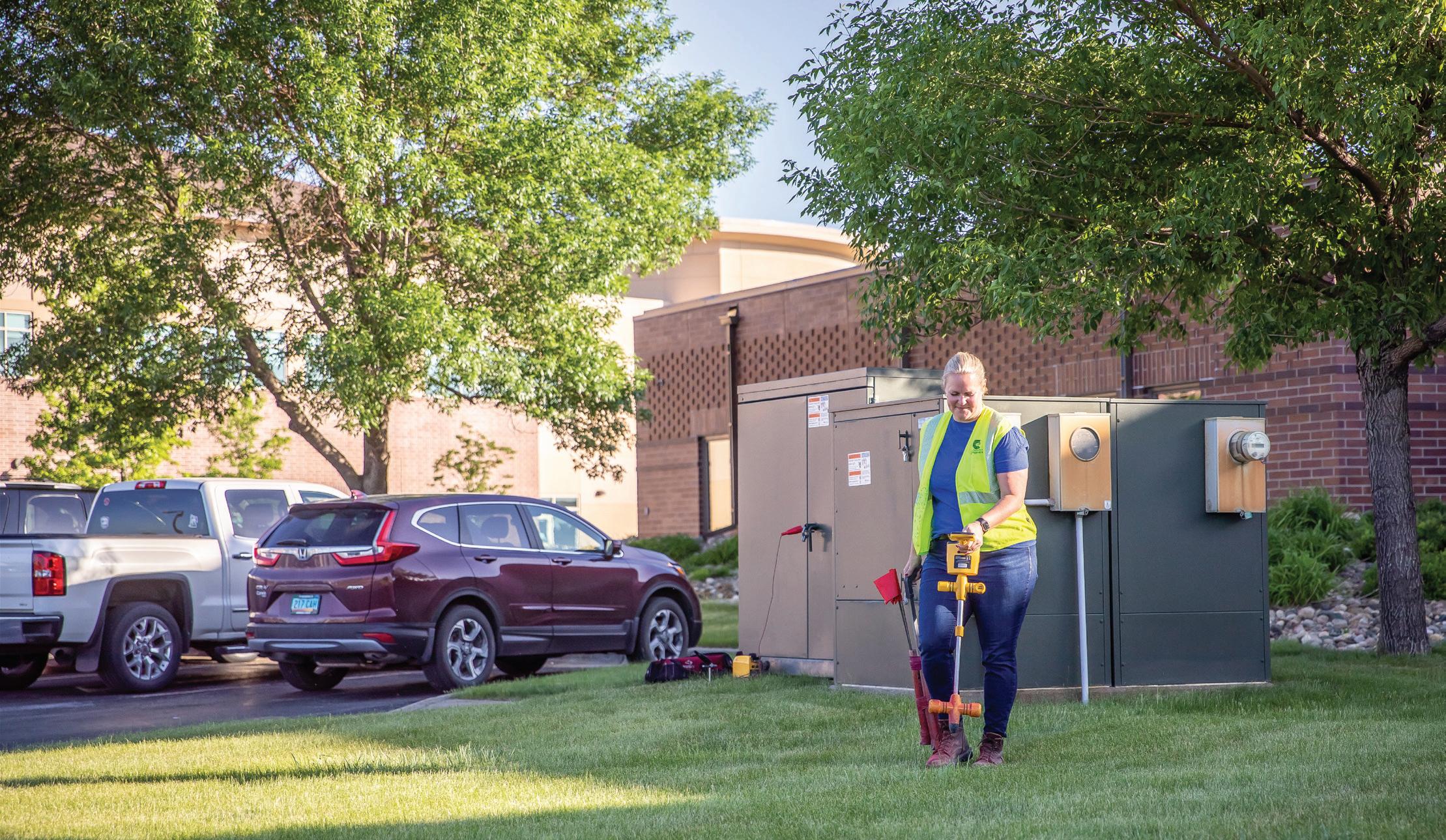HIGHLINE notes
February 2025

Powering our communities with heart, pg. 4
Sapa and Sanden to retire, pg. 6



Powering our communities with heart, pg. 4
Sapa and Sanden to retire, pg. 6

Paul Matthys, president/CEO, Cass County Electric Cooperative

Colder temperatures are taking hold across the nation, which is typical for this time of the year. As you know, the demand for energy rises when the temperature falls. We are well-prepared for the extreme cold and have adequate resources to supply our members with the energy they need. During times of extreme cold weather patterns, we rely on our wholesale power provider, Minnkota Power Cooperative, to supply power to us and the other cooperative families in eastern North Dakota and northwestern Minnesota.
Minnkota has a diverse energy supply portfolio with 34% wind (nameplate), 7% hydroelectric, 2% other (market purchases), and 57% from baseload lignite coal. We rely on our baseload resources during extreme cold or hot weather to keep the heat and lights on. We also utilize a robust demand response (off-peak) system to help
manage and balance our power supply needs and wholesale energy market purchases. CCEC is about a 270-megawatt (MW) system at peak, and with this demand response system, we can shed or curtail around 45 MW of our system load in the summer and 75 MW in the winter. Minnkota uses some of these control periods, called full load control (also known as red zone), for billing purposes and to avoid high-priced market purchases. For example, if we experience an extremely cold weather pattern, and our load exceeds our power supply resources, we can utilize our demand response system (control load) to avoid expensive market purchases. For participating in CCEC’s voluntary demand response (off-peak) programs, members receive a discounted electric rate for qualifying systems. If you have questions or are interested in participating in the program, please call and ask for our energy services team.
Looking at the bigger picture, I will discuss how the North American Electric Reliability Corporation (NERC) continues to sound the alarm on reliability. Much of the country, including the Upper Great Plains, faces an increasing risk of energy shortfalls over the next 10 years under normal and extreme weather conditions, according to NERC’s 2024 Long-Term Reliability Assessment (released on 1/2/2025).
The report's key details indicate that most of North America will face
reliability challenges as the demand for electricity increases and baseload power supply resources (e.g., coal, natural gas, and nuclear) continue to go offline. As we see early retirements of baseload resources, most new-generation resources are intermittent (wind and solar). Our country's areas with the most significant risk are in the Midcontinent Independent System Operator region, where we (Minnkota) participate.
NERC’s report directly points to the need for pro-energy policies and prioritizes reliability and affordability for American families, farms, and businesses. Jim Matheson, National Rural Electric Cooperative Association CEO, is working with NERC and urging them to prioritize these efforts on behalf of the nation’s cooperative members. “We urge President Trump and congressional leaders to prioritize reliability right out of the gate before it’s too late," he said.
We will continue promoting proenergy policies through our state legislators, local Chambers of Commerce, elected officials, and federal delegates. We will continue to preserve and maintain our baseload power supply resources, harden our systems, and strive for 100% reliability, all while keeping electricity rates stable and affordable. I also encourage you to support pro-energy policies and to let your voice be heard by your elected officials.
The Cass County Electric board of directors met in person on Dec. 20, 2024, and discussed the following topics:
• Moved to approve the December 2024 consent agenda of the regular board meeting consisting of minutes, monthly department reports, director expense report, and the November purchased power adjustment (PPA).
• Received the chairman’s report.
• President/CEO Paul Matthys gave the president’s report providing updates from meetings and conferences attended.
• Approved CEO Matthys to sign the Riverview Dairy agreement for ATC between Minnkota/Cass and Cass/ Riverview Dairy.
• Approved the non-union pay scale for 2025.
• Approved the union contract for 2025-2027.
• Approved the 2025 IT Audit- Scope
of Work Agreement with Eide Bailly, LLP.
• Approved the 2025 IT Security Audit with Red Siege.
• Approved the 2025 Letter of Engagement for the 2024 Financial Audit with Eide Bailly, LLP.
• Approved a modification to the 401(k) plan adoption agreement.
• Received the November 2024 financial report.
• The BOD approved the 2025 budget and the preliminary 2026 budget.
• Received reports from the Minnkota Power Cooperative and Square Butte Power Cooperative board meetings.
• Moved to approve the December 2024 capital credit estate payments.
• Reviewed upcoming meetings and events.
The next board meeting is scheduled for Tuesday, March 4, 2025.

Communications:
Morgan Bachelor
Jocelyn Lura Hovland
Printer:
Forum Communications Printing
Board of Directors:
Paul White, Secretary
Douglas Anderson
Vanessa Kummer
Stacey Ackerman
Tom Seymour
Glenn Mitzel, Board Chair
Wendy Loucks
Kalvin Hoff, Treasurer
Terry Kraft, Vice Chair
Executive Staff:
Paul Matthys, President/CEO
Jodi Bullinger, VP of Engineering & Operations
Chad Brousseau, VP of Member & Energy Services
Chad Sapa, VP of Corporate Services & CFO
Tim Sanden, VP of Information Technology & CIO

Highline Notes (USPS 244-740) is published monthly by Cass County Electric Cooperative Inc., 3312 42nd St. S., Suite 200, Fargo, ND 58104. Periodicals postage paid at Fargo, North Dakota 58104, and at additional mailing offices.
Postmaster: Send address changes to Highline Notes 3312 42nd St. S., Suite 200 Fargo, ND 58104

This Giving Hearts Day, Cass County Electric Cooperative (CCEC) is proud to support Valley Senior Services, an organization whose mission aligns closely with our own, effectively providing essential services to the communities we serve. Since 1971, Valley Senior Services has been a trusted resource for seniors in the southern Red River Valley, helping seniors maintain independence through transportation, homedelivered meals, community dining, resource services, recreational activities, and more. They serve individuals aged 60+ in Cass, Richland, Ransom, Sargent, Traill, and Steele counties.

Valley Senior Services addresses the growing needs of an aging population. By 2025, 25% of North Dakota's population will be aged 60 or older, mirroring the national trend of rapid population aging. With over 11,200 Americans turning 65 daily, this need will continue to rise. Their services include Meals on Wheels, which delivers nearly 255,000 meals annually 199,000 in Cass County alone and provides a lifeline for those unable to prepare their own food. Senior Transportation is another critical program, offering over 49,000 rides annually for medical appointments, grocery shopping, and social events. Additionally, Valley Senior Services fosters well-being through health and wellness programs, outreach services, and congregate meal sites at 32 locations.
As part of this year’s Giving Hearts Day initiative, CCEC employees will be completing a heartfelt service
project by creating valentines to bring joy to seniors in our area, made a donation to further their programs, and invited Valley Senior Services to our office for a special lunch-and-learn presentation. During this event, employees will gain insight into the crucial work Valley Senior Services does daily. Representatives will share stories of how a delivered meal or a ride to a medical appointment can be lifechanging for seniors.
“At Cass County Electric, we believe in empowering the communities we serve, and Giving Hearts Day offers us a meaningful opportunity to do just that,” said Jocelyn Hovland, Communications Manager at CCEC. “We see Valley Senior Services as a deserving recipient because their mission to support seniors is vital to the same areas we power every day. Like electricity, their services are essential to the well-being of our communities.”

For over a decade, CCEC employees have been personally delivering meals twice a month through the Meals on Wheels program, building connections and fostering care for our neighbors. The synergy between CCEC and Valley Senior Services stems from our shared commitment to providing critical resources to rural and urban areas alike. Just as CCEC delivers reliable energy to homes and businesses, Valley Senior Services ensures that older adults have access to nutritious meals,
reliable transportation, and social connections. Both organizations understand that these fundamental services help build strong, resilient communities.
CCEC’s involvement in Giving Hearts Day is just one way we live out our cooperative values of community, service, and care. By supporting Valley Senior Services, we’re helping to ensure that seniors across North Dakota can continue to live with dignity and independence. Together, we’re lighting the way for brighter days ahead.
As Giving Hearts Day approaches, we encourage others to join us in supporting Valley Senior Services. Whether it’s through a donation, volunteering, or simply spreading the word, your contribution can make a world of difference. Visit valleyseniorservices.org/volunteer or call 701-293-1440 to sign up as a
volunteer or support their programs at valleyseniorservices.org/donate. At CCEC, we believe that when we come together, we can power not just homes, but hearts and lives too.

Cass County Electric Cooperative (CCEC) was built by the communities we proudly serve. Guided by our mission to provide reliable, sustainable, and affordable energy, we remain deeply committed to meeting the needs of our local members—because, unlike investor-owned utilities, we answer to you, not faraway shareholders. As a local organization made up of your friends and neighbors, we’re continually striving to make a positive impact beyond delivering electricity.
Each year, approximately onequarter of CCEC’s nonprofit contributions are dedicated to Giving Hearts Day, a cause that holds a special place in our hearts. We’re excited to share that, for the fourth year, we’re participating in the Giving Hearts Day Employee Match Program. Through this initiative, CCEC will allocate funds to match employee donations to Giving Hearts Day charities, up to $50 per employee. To qualify, organizations must provide services within our 10-county service area.
To amplify these contributions, we encourage our employees to go a step further by volunteering their time with these exceptional organizations. By combining innovation with the values that define our community, we have the opportunity to create meaningful change. Together with you, our members, we’re shaping a community we can all be proud to call home. That shared purpose fuels our energy at Cass County Electric Cooperative—we’re here to power your life, today and every day.
Long-time cooperative leaders Tim Sanden (CIO) and Chad Sapa (CFO) to retire April 2025
“We’re just a couple of guys who loved what we did. And maybe we got a bit lucky along the way.” - Paul Newman to Clint Eastwood
Tim Sanden has been quoting this exchange between Hollywood greats a lot lately. On April 1, 2025, Sanden will retire as CIO and Vice President of Information Technology at Cass County Electric Cooperative (CCEC) – on the very same day as his long-time colleague, Chad Sapa, who will step down from his role as CFO and Vice President of Corporate Services. The two have been through a lot together over their co-op tenures (a combined 73 years of service between them), but their trails first merged long before in Moorhead, Minnesota.
“Chad and I graduated from the same high school the same year. So, we graduated from high

Chad Sapa CFO & VP of Corporate Services
Oct. 1991 - April 2025
school at the same time, and we’re graduating from work at the same time,” Sanden chuckled. “When we walk out the door, for me, it will have been 40 years. But the time has gone by in the blink of an eye.”
“I've been blessed to have a dream job that I really enjoy for 33 and a half years,” Sapa said. “I feel privileged to be able to be in the position I'm in for a company that I really, really enjoy working for.”
The finance guy
The first thing Chad Sapa does when he gets to work in the morning is flip on CNBC. He has a small TV specifically for it. “I’m probably the only co-op employee in the whole state of North Dakota that has it on in their office all day long,” he said. “It helps to stay in tune to the pulse of the economy, interest rates, what the markets are doing. It's invaluable.”
Sapa lives for finance. He was hired in 1991 as the co-op’s first financial analyst, and his charge was to guide CCEC to a solid balance sheet, strengthen its financial future, keep rates stable, and work with Sanden to manage several subsidiary activities that were popular for coops in the ‘90s (e.g., wireless cable TV, telephone, etc.). He dove in, breaking from “we’ve always done it this way” norms and setting up the financial structures that would ultimately make the subsidiary efforts profitable. This allowed CCEC, one of the country’s fastest growing co-ops, to eventually sell its subsidiaries and concentrate on the core business they were created for – delivering power.
Once Sapa was named CFO in 1998, the co-op’s financial standing continued to improve as its member accounts skyrocketed. Over 26 years, CCEC went from 19,000 members to more than 59,500 members, with margins growing from $1.4 million to nearly $8 million. The co-op grew its equity from 25% to 47%, which is a key indicator of financial stability.
“I'm very proud of where the company is today from a financial perspective. I think I’ve had a part of that,” Sapa said. “But it's been a team effort, with all the employees and our board and our management team all buying in and giving me a lot of flexibility to suggest changes 26 years ago.”
CCEC is currently in the top 9% of 800 nationwide cooperatives for new account growth, but the co-op has remained cost efficient through the boom. In fact, even through a pandemic that ballooned inflation, Sapa and his team were able to keep electric rates stable for members for eight solid years (20172025).
“That was probably the icing on the cake for me, was our annual meeting in 2024. I like getting in front of people, especially our membership, and making finance fun,” Sapa said. “The pinnacle was being able to just get the pom poms up and be excited about rates that are flat.”
When Sapa retires in April, his role will be filled by Andy Weiss, who currently serves as CCEC’s controller. Weiss says he is “honored and excited” to continue the legacy of excellence that has been built, in
great part, by Sapa.
“With his unwavering demeanor and strong technical skills, he’s been able to provide strong assurance to our employees, members, and board of directors that the cooperative is in good hands financially,” Weiss said. “He’s committed to being innovative and creative at the cooperative, taking pride in the cooperative's ability to do the same.”
When Tim Sanden was hired at CCEC as a computer programmer in 1985, fresh out of college, he didn’t walk into a technology environment that had cellphones, internet, or even word processors. But what CCEC did have was know-how and initiative.
“At that time, we were writing all of our own software,” Sanden recalled. “To the best of our knowledge, Cass County Electric, headquartered in Kindred, North Dakota, at the time, was the first cooperative in the nation to have in-house data processing, starting in 1959.”
Together with CCEC’s John Haugen (boss and mentor to both Sanden and Sapa), Sanden wrote and deployed modules that helped the co-op run efficiently and keep accounts in order. Those concepts and software were used until the late 1990s, when the co-op converted its accounting systems to a national provider’s software. The transition was an enormous undertaking for Sanden, but he’d been learning from the best.
“Shortly after I started in 1985, he (Haugen) gave me the frame of reference for what Cass County does with its members. There was a new program that we were working on, and we were figuring out how we were going to program it – it

could have been done a number of different ways,” Sanden said. “He stops and sits back and he says, ‘What would be best for the member?’ That is the overriding idea that drove all the decisions. And I still see that here today.”
The membership has been at the forefront of Sanden’s decisionmaking since before he was named CIO at the turn of the 21st century. Along with integrating technologies that made the co-op’s grid smarter and more resilient, he helped established a North Dakota chapter of InfraGard, a partnership between the FBI and the private sector for the physical and cyber protection of the nation’s critical infrastructure. Cybersecurity continues to grow in importance for the co-op, and it will continue to be a priority when Sanden’s successor, Mitch Lyter, takes the technology reins.
“We’re so privileged to work for a company that does important critical work. We heat people's homes, we keep their food cold – it’s really lifesaving, critical stuff that electricity provides,” Sanden said. “I wouldn't have wanted to spend my career anywhere else.”
Knowing they will be leaving the cooperative in a strong place,
Tim Sanden CIO & VP of Information Technology
April 1985 - April 2025
Sanden and Sapa have no qualms about enjoying their retirements. Both will spend more time at the lake ice fishing (Sanden) and water skiing (Sapa), and more time with their kids and grandkids. But it won’t be the last the co-op hears from them.
“Chad and I have talked,” Sanden said. “We don't want to do complete separation, so our plan is to find some time to get together and send back some pictures to the people who are still working: ‘Wish you were here!’” he added with a sly grin.
toCongratulations the other CCEC employees who have or have announced their intent to retire in 2025:
Paul Kautz
Manager of Information Systems
Nov. 1995 - Jan. 2025
Ron Ness Manager of System Operations
Feb. 1987 - March 2025
Darren Andersen Fleet Supervisor
Oct. 1997 - April 2025

Cass County Electric Cooperative (CCEC) prides itself on the relationship it has built with its members – a relationship based on reliable service, financial responsibility, public safety and transparency. With these tenants of trust in mind, we want to update our members on circumstances that may influence financial decisions made by your co-op board and staff in the near future.
Minnkota Power Cooperative (our wholesale power provider) has worked hard to keep its electric rates stable and unchanged throughout the volatility of the pandemic and the years that followed. In fact, Minnkota has not adjusted its rates in eight years (April 2017). However, with inflationary pressures, supply chain challenges, and the pace of industry change continuing to grow, Minnkota has made the difficult decision of increasing its average wholesale power
rateby 8.3% in April 2025.
Understandably, a rate increase from Minnkota will add pressure to CCEC’s electric rate to our members as well, and our team will need to act accordingly to continue to provide the service you expect and deserve.
You may be asking why a rate adjustment is coming now. To understand the urgency of the matter, consider the increase in cost of critical power materials since 2020: The average cost to build a mile of transmission power line is up 40%, with the line itself (conductor) up 46% and other key components up over 65%. The costs involved in providing electricity continue to be impacted at a higher rate.
We want to assure you that rate adjustments are only considered when necessary. Minnkota and CCEC are not-for-profit cooperatives, so our sole purpose is to serve our members – not to
make money for shareholders. And we are not the only electric utilities facing these difficult decisions. Utilities across the nation are experiencing the same inflationary pressures and cost increases.
If you’re concerned a potential electric rate increase could lead to financial difficulties in your household, remember that CCEC and its partners offer programs to help. From energy efficiency programs to payment assistance, we can help you find the path that will work best for you. If you have questions about rates or need assistance, please don’t hesitate to call the office at 701356-4400.
We will have more detailed information on the rate adjustment in the months to come. We thank you, our valued members, for your patience and understanding.



Scan here for more safety tips!
While typically not an everyday occurrence, overhead power lines, padmount transformers (green boxes) or other electrical equipment can become damaged due to storms, fires, car accidents, animal interference or from a car slipping off the road, for example.
(Spoiler Alert: Do not do any of these things.) If you were in an accident involving a downed overhead power line, would you get out of the car and run? If you saw a car accident involving a downed line or damaged green box, would you run to the scene to help? If you saw a downed line across a road, would you approach it or try to move it?
Any of these actions can cause serious injury or electrocution (death). Downed lines and other damaged equipment can energize the ground, nearby people, and
objects. Never go near a downed power line or try to move it with an object. Electricity can jump from a wire or object to you to find the quickest path to ground.
The safest place to be after an accident involving a downed power line is inside your vehicle or cab. Unless your vehicle is on fire or giving off smoke, here is what you should do:
1. Stay inside your vehicle or cab.
2. Call 9-1-1 and report that there are downed or damaged power lines.
3. Try to remain calm.
4. Wait for the utility crew to arrive to deenergize the power.
5. Do not get out until someone from the utility says it is safe to do so.
If you must get out of the vehicle because it is on fire, cross your arms over your chest and make
a clean, solid jump out, then intentionally hop with your feet together as far away as you can. If you are unable to make solid hops, shuffle with your feet close together.
When you exit, do not touch the vehicle and the ground at the same time. You could become electricity’s path to ground from touch potential (touching something energized and the ground at the same time).
Hopping helps avoid step potential (placing each foot at a different voltage). When electricity escapes into the ground, it is likened to ripples in a pond, with each ripple representing a different voltage.
To learn more about electrical safety, visit CassCountyElectric. com/safetyblog.


Fleet Technician
Michael Klockmann
Hometown:
Enderlin, North Dakota
Tell us about your education: I graduated from Enderlin High School and then went on to NDSCS, where I received my associate's degree in Applied Automotive Science. I also received my ASE Master Certification and GM World Class Certification in engine mechanics.
Tell us about your family:
I am married to my lovely wife Sarah and have three grown boys and one cat.
If you won the lottery, what would be your first purchase?
Pay off debt, restore my collector car, and take an extended vacation.
What’s your dream vacation? France
Tell us about your career: After graduating from NDSCS, I started working for a GM dealer in Lisbon, North Dakota. From there, I spent 13 years working for Gateway Chevrolet, then multiple aftermarket shops, including D&S Service, Matt’s Auto, and Road Runner Auto in Kindred, North Dakota.
Hobbies:
I enjoy four-wheeling, trail riding, camping with family and friends, car shows, woodworking, and being creative in general.
What’s your favorite season?
Spring would be my favorite, and summer is a close second.
What’s your favorite food? I have so many; I love to try new things.


Many homes across our service area have unique heating systems that reflect the challenges of the past. Back in the day, when natural gas wasn’t readily available and propane was prohibitively expensive, many homeowners turned to all-electric heat. For many, this meant installing electric baseboard heaters, as they required no ductwork and were straightforward to install. While these systems have served residents well for decades, they are often not the most cost-efficient, especially when it comes to managing today’s energy costs.
Heating and cooling can account for over 40% of a household’s utility bill, and for homes using electric baseboard heat, that percentage may be even higher. Thankfully, advancements in technology have provided tools to help manage these costs more effectively, and one such tool is the programmable or smart thermostat designed specifically for electric baseboard heaters.
Unlike traditional thermostats, digital and smart thermostats
for baseboard heaters offer precise temperature control and the ability to set schedules that match your lifestyle. For example, you can program the thermostat to lower the temperature automatically when you’re at work or asleep and then raise it before you get home or wake up. This ensures you’re not wasting energy heating your home when it’s unnecessary. Additionally, many smart thermostats can be controlled remotely via a smartphone app, allowing you to adjust settings on the go and monitor your energy usage in real time.
The savings from using a programmable thermostat can be significant. By reducing energy waste, you can lower your heating costs while maintaining a comfortable living environment. For installation and safety, consider contacting a qualified electrician to help set up your new thermostat. These savings are especially impactful for homes with electric baseboard heating, where small changes in usage can lead to noticeable differences in monthly utility bills.
To maximize your savings, we encourage you to explore Cass County Electric Cooperative’s time-of-day program. By shifting your energy usage to nonpeak hours—when demand and rates are lower—you can take advantage of reduced electricity costs. This program is an excellent complement to a programmable thermostat, as you can schedule your heating to align with non-peak periods.
For more information about how our time-of-day program works and whether it’s a good fit for your home, contact our energy management team at energy@kwh.com. They’re here to help you find ways to save energy and money while staying comfortable year-round.
If your home relies on electric baseboard heating, now is the perfect time to invest in a digital thermostat and explore energy-saving programs like off-peak. By making these small but impactful changes, you’ll not only lower your utility bills but also contribute to a more energy-efficient future.
Check out our Pinterest page for more recipes!

Ingredients
1 bag (12 ounces) egg noodles, prepared
8 thick slices of Velveeta cheese
2 cups carrots, sliced
1 onion, halved and ringed
1 green pepper, halved and ringed
Nothing says 'Midwest comfort' quite like a good hotdish. Whether you're feeding the family, the neighbors, or the whole church basement, these recipes bring the warmth, the flavor, and just the right amount of 'you betcha!' to your table. Grab your casserole dish and let’s get cookin’!
Ingredients

2 pounds hamburger, seasoned & browned
2 small cans of V8 juice (5.5 ounces/ea)
2 small cans of Spicy Hot V8 juice (5.5 ounces/ea)
½ teaspoon Worcestershire sauce
1 teaspoon garlic salt
Pepper to taste
Preparation
Layer the noodles and browned hamburger and cover with the cheese slices, onion, carrots, and green peppers. Mix tomato juices, Worcestershire sauce, and seasonings and pour over the mixture in a 9x13inch pan. Bake uncovered for 30 minutes at 350° F.
Ingredients
6 ounces macaroni noodles, prepared
1, 12-ounce can corned beef, shredded
¼ pound Velveeta, cubed
¾ cup milk
1 can cream of mushroom soup
½ cup onion, finely chopped
Salt and pepper to taste
Ruffles original potato chips
Preparation
Combine all ingredients, mix well, place in a two-quart casserole dish, top with crushed original potato chips, and bake uncovered for one hour at 350° F.
1 ½ cup rotini noodles, prepared
1 ½ pounds hamburger, seasoned & browned
2, 6-ounce bags of mini pepperoni slices
8 ounces mozzarella cheese (1/2 bag), shredded
8 ounces pepperjack cheese (1/2 bag), shredded
1 green pepper, chopped
1 onion, chopped
1 large jar Ragu spaghetti sauce (24 ounces)
Salt and pepper to taste
Preparation
Combine all ingredients, mix well, place in a two-quart casserole dish, and bake uncovered for one hour at 350° F. Sprinkle additional mozzarella cheese on top for the last 10 minutes.
Ingredients
2 ½ cups egg noodles, prepared
1 can Spam, cubed
8 ounces Velveeta cheese, cubed
¾ cup milk
1 can cream of mushroom soup
1 can corn, drained
Salt and pepper to taste
Preparation
Combine all ingredients, mix well, place in a two-quart casserole dish, and bake uncovered for 30 minutes at 350° F.
Ingredients
½ bag (6 ounces) egg noodles, prepared
2, 5-ounce cans tuna in water, drained
½ cup Velveeta cheese, cubed
1 can cream of mushroom soup
½ cup onion, finely chopped
½ cup celery, finely chopped
Salt and pepper to taste
Ruffles original potato chips
Preparation
Combine all ingredients, mix well, place in a two-quart casserole dish, add crushed chips, add a few dollops of butter and bake uncovered for 45 minutes at 350° F.

Were you one of many children who was told by a parent, “Turn off the lights when you leave the room! Our electric bill will be sky high!”? Although switching off the lights is great advice, your lighting actually accounts for a very small percentage of the energy your home uses every month.
According to the U.S. Energy Information Administration, space heating is the largest user, consuming an average of 43% of a household’s energy. Water heating comes in a distant second, using 19% of your home’s energy.
Here's a breakdown:
• Space heating: 43%
• Water heating: 19%
• Air conditioning: 8%
• Lighting: 5%
• Refrigeration: 3%
• Other appliances and electronics: 21%
Since heating your rooms and water uses the most energy, that’s the best place to start if you’re looking to lower your monthly utility bills. Here are some suggestions from CCEC to get started.
• In the winter, turn your thermostat down to 65 degrees (if comfortable).
• Don’t block inside vents or outside units.
• See if your heating system qualifies for CCEC's off-peak heating program, which can save you nearly 50% on heating costs through the cold season. If you’re not sure, ask the folks at the co-op!
• Make sure your water temperature is set to 120 degrees.
• Use cold water for standard laundry loads.
• Install a large-capacity electric water heater and enroll in the off-peak water heating program. Not only will you receive a large co-op rebate (up to $700), but you’ll also receive a reduced electric rate on your water heater, which will warm water at lowdemand times of day (usually overnight) and keep it hot throughout the day.
Learn more about off-peak heating and water heating at valueofelectricity.com.
All ads must be 40 words or fewer and will be abbreviated following our guidelines. No real estate or commercial ads will be accepted. Ads are published for members at no charge as space permits on a first-received, first-printed basis. Ads are due by the 10th of the month prior to publication. Members may submit only one ad per issue. Editor reserves the right to edit or reject any ad. Email ads to: ccec@kwh.com
For sale:
Electric stove, 25’’Hx20’’Lx12’’D, has all controls, heat, & flame. Electric pizza oven, large size. 218-593-7023
Simplicity DLX riding tractor, new 20 hp engine at 600 hrs. 42” snowblower, 50” mower deck, rear wheel chains, $3,500. 60” JD power broom fits JD X Series, new brushes & bearings, $2,700. Murray 30” riding mower w/ good 10 hp TEC engine, $750. 701-261-1647
Antique wooden trunks, 32”x19”x13” & 38”x22”x27”, $60 for small, $100 for large. 218-790-8131
750 Honda Shadow, 3400 mi, great shape, custom-paint job, $3,300. 701840-0470
Craftsman SB450 snowblower, 26” 208cc 2 stage, serviced by Scheels, used sparingly, like new, paid $900 new, $650/OBO. 701-280-1564
GERSTNER oak 6-drawer chest wellsuited for storing hobby supplies or Craftsman tools, front lid stows
under drawers in the open position & covers drawers in the closed position, green felt-lined, 20" W x 9" D x 111/2"H, $150. 701-361-3039
3 tires, 235-6R18, after 7 pm. 701-2004059
2005 Honda VTX 1800cc, less than 13,000 mi, fuel injected, custom turn signals, very clean, well maintained, priced to sell, $4,950/OBO. 701-3178725
2003 Harley Davidson Fatboy (100 anni.), 13,000 mi, fuel injected, detachable windshield, screaming eagle pipes, lockable saddlebags, chrome swingarm, pics avail., $6,500. 701-361-2551
Wanted: Rotary/carousel slide projector compatible w/ gaf rotary slide trays. 701-541-7977
3 used 225 75/R15 tires suitable that hold air. To be used on portable deer stand trailer, no highway use. 701371-8111

Gallon of Milk
1937... $0.10
2025... $4.33
Increase...43x
Electricity
1937... 5¢/kWh
2025... 11¢/kWh
Increase... 2x
Affordable, reliable electricity is something you can count on as a cooperative member. While the cost of everyday items has increased, the cost of electricity has remained a powerful value.


Set your thermostat to around 55°F. This temperature is warm enough to prevent issues like frozen pipes while keeping energy costs down. If you have a smart thermostat, use its vacation mode to maintain efficiency and remotely monitor or adjust the temperature.
Unplug electronics like TVs, computers, and unnecessary kitchen appliances to prevent energy “vampires” that continue to draw power even when off. This also reduces fire risks.
Consider installing motion-sensor lights or setting up timed lights inside to give the appearance that someone is home, deterring burglars and keeping your home safe.